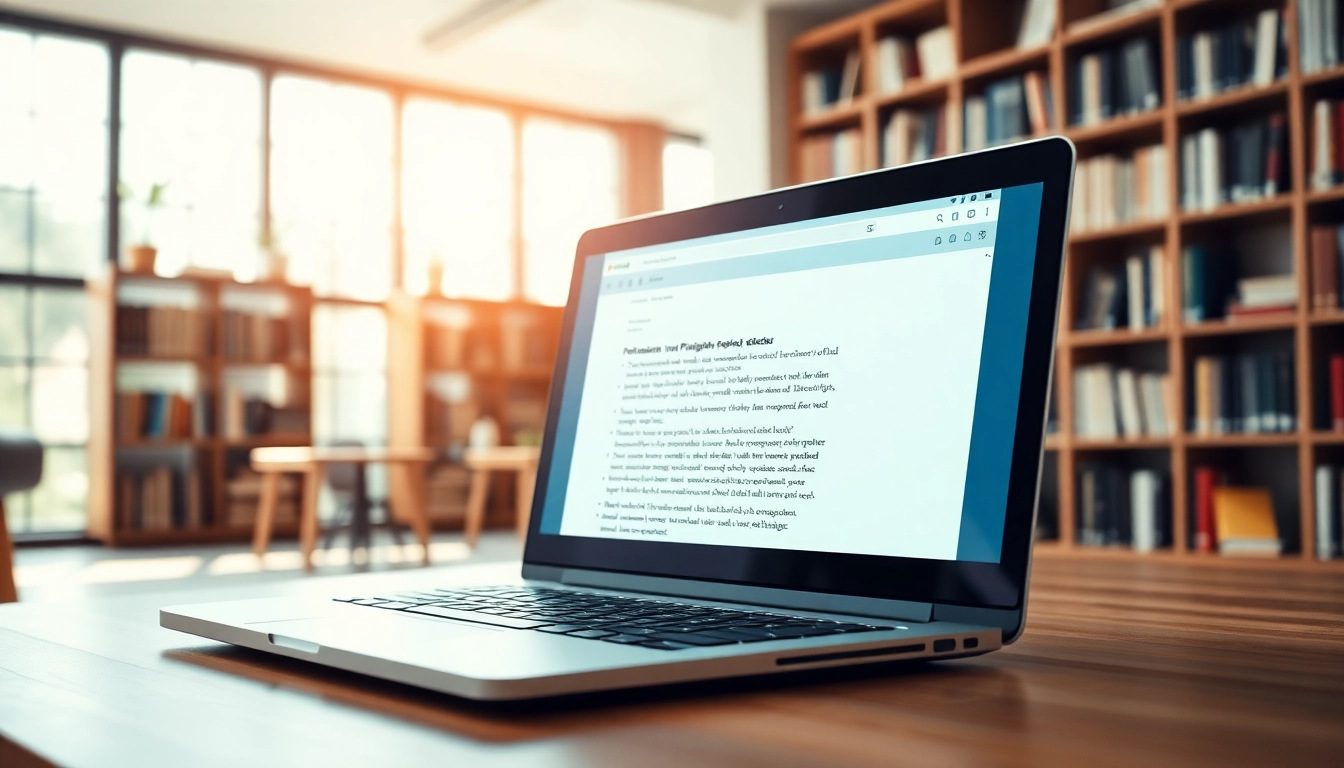Effective Strategies for Using a Plagiarism Checker to Ensure Originality
Understanding the Importance of a Plagiarism Checker
In the digital age, where information is shared rapidly and content creation has become ubiquitous, maintaining originality in written work is crucial. This is where the role of a plagiarism checker comes into play. These tools serve as a safeguard against unintentional plagiarism, ensuring that writers uphold the integrity of their work. Understanding why originality matters, the consequences of plagiarism, and the essential functions of plagiarism checkers is vital for anyone engaged in academic or professional writing.
Why Originality Matters in Academic and Professional Writing
Originality is the bedrock of academic and professional exploration. In academics, original work demonstrates a student’s ability to synthesize information, think critically, and contribute new ideas to their field. For professionals, originality builds credibility and establishes a voice that can engage audiences and foster trust. It reflects personal integrity and respect for the contributions of others, as well as adherence to ethical guidelines that govern both academia and business.
Consequences of Plagiarism in Various Fields
Plagiarism can lead to serious consequences in academic and professional environments. For students, being found guilty of plagiarism can result in penalties ranging from failing grades to expulsion. In the professional realm, instances of plagiarism can damage reputations, leading to loss of jobs and damaged relationships. Additionally, legal ramifications can arise if copyrighted material is used without permission, underscoring the high stakes associated with the use of unoriginal content.
The Role of a Plagiarism Checker in Maintaining Integrity
A plagiarism checker serves as an essential tool to help individuals detect and address instances of plagiarism before submission. By scanning documents for similarities against global databases, these tools provide writers with insights into the originality of their work. This not only allows for the correction of potential issues but also promotes a culture of academic honesty and accountability, ultimately enhancing the quality of writing.
How to Choose the Right Plagiarism Checker
As the market for plagiarism detection continues to evolve, selecting the right tool can be challenging. Key factors to consider include features, cost, user reviews, and performance metrics.
Key Features to Look for in a Plagiarism Checker
When evaluating plagiarism checkers, several features can enhance their utility:
- Comprehensive Database: A good plagiarism checker should have access to a large database that includes academic journals, publications, and website content.
- Real-time Results: Immediate feedback allows writers to make necessary corrections on the spot.
- User-friendly Interface: Easy navigation ensures that users can understand and utilize the tool effectively.
- Customizable Settings: The ability to focus on specific types of content or check certain sources can enhance relevance for various users.
Cost-Effective Options for Students and Professionals
For students and professionals working with tight budgets, cost-effective plagiarism checkers are vital. Some platforms offer free versions with limited functionality, which can be suitable for initial checks. However, investing in a premium service may be beneficial for those who require advanced features and more extensive databases. Educational institutions often provide access to reputable plagiarism checkers, so it’s advisable to explore these resources first.
User Reviews and Performance Ratings of Plagiarism Checkers
Before selecting a plagiarism checker, reviewing user feedback can provide insight into its effectiveness and usability. Check ratings on trusted sites and consider the experiences of others, especially those in similar fields. Performance metrics, such as detection accuracy and response time, can significantly influence the decision-making process.
Steps to Effectively Use a Plagiarism Checker
Using a plagiarism checker effectively involves several key steps, from document preparation to interpreting the results.
Preparing Your Document for Analysis
Before running a document through a plagiarism checker, it is essential to prepare it properly. This includes:
- Ensuring that the document is free from excessive formatting that might confuse the detection tool.
- Saving the document in a supported file format to ensure compatibility.
- Reviewing the content to identify any areas that might require additional citation or paraphrasing.
Interpreting the Results of the Plagiarism Checker
Once the analysis is complete, understanding the results is crucial. Most plagiarism checkers will highlight sections of text that appear similar to other sources. It is essential to:
- Review each flagged section closely to determine whether it constitutes plagiarism or is merely a common phrase.
- Check the sources to which the tool indicates similarities, ensuring accuracy in assessing ownership and citation needs.
Implementing Suggestions to Improve Originality
After interpreting the results, the next step is implementing changes to enhance originality. This may involve:
- Revising or paraphrasing identified sections using original language.
- Adding proper citations for paraphrased or borrowed ideas.
- Incorporating unique insights or viewpoints to enrich the content.
Common Challenges When Using a Plagiarism Checker
Despite their utility, plagiarism checkers are not without challenges. Understanding these potential pitfalls is crucial for users seeking effective originality assessments.
Limitations of Automated Detection Tools
While automated tools are valuable, they come with limitations. For instance, plagiarism checkers may struggle with nuanced differences in phrasing or fail to detect non-exact matches, leading to both false positives and negatives. This means that users must supplement automated checks with manual reviews to ensure comprehensive analysis.
Addressing False Positives and Negatives
To navigate the inherent inaccuracies of automated checks, users should adopt a critical approach when reviewing reports. Cross-reference flagged sections with original sources to confirm whether plagiarism is present. Additionally, providing feedback to the tool developers about inaccuracies can help improve their algorithms over time.
Strategies to Improve Writing to Avoid Plagiarism
Writers can enhance their original writing skills, thus reducing reliance on plagiarism checkers. Strategies include:
- Developing a strong personal writing style that emphasizes individuality and insight.
- Practicing proper paraphrasing and summarization techniques to convey ideas without relying too much on original phrases.
- Regularly reading to expose oneself to various writing styles and how ideas can be communicated differently.
Future Trends in Plagiarism Detection Technology
The landscape of plagiarism detection is constantly evolving. Emerging trends indicate that future plagiarism checkers will enhance accuracy, comprehensiveness, and user experience.
The Impact of AI and Machine Learning on Plagiarism Checkers
With advancements in technology, plagiarism detection tools are increasingly integrating artificial intelligence and machine learning capabilities. This progress promises to enhance the accuracy of detection algorithms, leading to more reliable assessments and faster results. AI technologies can improve contextual understanding, enabling plagiarism checkers to discern intent and recognize paraphrased content effectively.
How Content Generation Tools are Changing the Landscape
The rise of AI content generation tools also impacts plagiarism detection. As these tools create high volumes of text that might mirror existing content, plagiarism checkers must adapt to identify potential issues effectively. Future tools may incorporate capabilities to assess originality based not only on text similarity but also on the underlying ideas and constructs.
Preparing for the Future of Academic Integrity
As technology continues to advance, the emphasis on academic integrity remains paramount. Educational institutions and content creators must remain vigilant and adaptable, adopting new tools and strategies to uphold originality standards. Efforts to educate writers on ethical practices in content creation will be vital to ensure a responsible and innovative future in academia and beyond.



